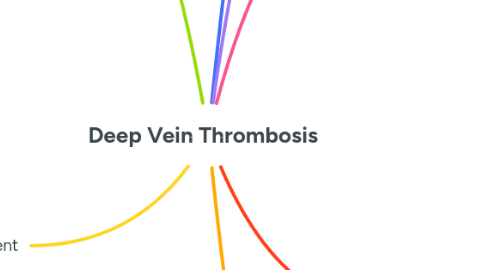
1. Diganosis
1.1. Doppler Ultrasound (gold standard)
1.2. . D-dimer Test
1.3. Magnetic Resonance Imaging (MRI)
1.4. Physical exam
2. Treatment
2.1. Anticoagulants
2.1.1. Warfarin (Coumadin)
2.1.2. Direct Oral Anticoagulants (DOACs
2.1.2.1. Apixaban (Eliquis)
2.1.2.2. Dabigatran (Pradaxa)
2.1.2.3. Edoxaban (Savaysa)
2.1.3. Unfractionated Heparin (UFH)
2.1.3.1. Low Molecular Weight Heparin
2.2. Compression stockings
2.3. Thrombolytic therapy
2.3.1. Alteplase (tPA)
2.3.2. Reteplase
2.3.3. Streptokinase
2.4. Surgical interventions
2.5. Lifestyle modifactions
2.5.1. mobiliy increase
2.5.2. diet changes
2.6. Inferior Vena Cava (IVC) Filter
2.6.1. Device inserted in the inferior vena cava to collect blood clots prior to them traveling in the lungs and leading to a pulmonary embolism
3. Etiology
3.1. Deep Vein Thrombosis is multifactor and can have different factors that contribute to the cause of it.
3.1.1. The Virchow's Triad
3.1.1.1. Venous Stasis (slowed or immoblie blood flow)
3.1.1.1.1. blood flow slowing down because of immobility
3.1.1.2. Endothelial Injury (damaged blood vessel)
3.1.1.2.1. trauma, surgery, or inflammation can damage the vein
3.1.1.3. Hypercoagulability (increased tendency of the blood to clot)
3.1.1.3.1. an elevated level of clotting factors fibrinogen, platelets, or clotting proteins
4. Pathophysiology
4.1. When a blood clot forms in the vein. Usually occurs in the legs and deep veins.
5. Signs and Symptoms
5.1. Edema in the legs
5.2. Strong pain
5.3. Tenderness
5.4. Color Change in the calf area, usually reddneing
5.5. Warmth over the area
6. Impact on other body systems
6.1. Cardiovascular
6.1.1. risk of a PE (pulmonary embolism) leading to right heart failure.
6.2. Respiratory
6.2.1. A pulmonary embolism caused by DVT can lead to difficulties in breathing, chest pain, and hypoxia
6.3. Musculoskeletal
6.3.1. pain, swelling, and post-thrombotic syndrome.
6.4. Integumentary
6.4.1. skin discoloration, ulcers, and weakened wound healing.
6.5. Renal
6.5.1. decreases kidney function from hypoxia or excess fluid retention.
6.6. Neurological
6.6.1. confusion, dizziness, and stroke
6.7. Endocrine
6.7.1. triggers a stress response, elevating blood pressure and blood sugar.
7. Complications
7.1. Pulmonary Emblosim
7.1.1. blood clots escape from deep veins and and causing a blockage in the lungs, and the pulmonary artery.
7.2. Post-Thrombotic Syndrome (PTS)
7.2.1. long-term complication of DVT that can happen after a signficant amount of time from the clot being formed. PTS comes from the damage that the clot does to the veins, affecting blood circulation in the limb.
